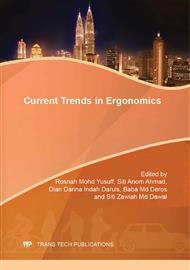[1]
Y. K. Kong, S. J. Lee, B. D. Lowe, S. Song, Evaluation of various handle grip spans for optimizing finger specific force based on the users' hand sizes. Human Factors and Ergonomics Society Annual Meeting Proceedings, Industrial Ergonomics, (2008).
DOI: 10.1177/154193120705101504
Google Scholar
[2]
H.Y. Shin, S.W. Kim, J.M. Kim, I.M. Shin, J. S. Yoon, Association of grip strength with dementia in a Korean older population, Journal of Geriatric Psychiatry, 27 (2012) 500–505.
DOI: 10.1002/gps.2742
Google Scholar
[3]
E. J. Carey, T. J. Gallwey, Effects of wrist posture, pace and exertion on Discomfort, International Journal of Industrial Ergonomics, 29 (2002) 85-94.
DOI: 10.1016/s0169-8141(01)00053-1
Google Scholar
[4]
M. S. Hallbeck, D. L. McMullin, Maximal power grasp and three-jaw chuck pinch force as a function of wrist position, age, and glove type. International Journal of Industrial Ergonomics, 11 (1993) 195-206.
DOI: 10.1016/0169-8141(93)90108-p
Google Scholar
[5]
M. M. Schlüssel, L. A. Anjos, G. Kac, Hand grip strength test and its use in nutritional assessment, Rev. Nutr., 21 (2008) 233-235.
Google Scholar
[6]
M. L. Lu, T. James, B. Lowe, M. Barrero, Y. K. Kong, An investigation of hand forces and postures for using selected mechanical pipettes. International Journal of Industrial Ergonomics, 38 (2008) 18-29.
DOI: 10.1016/j.ergon.2007.08.006
Google Scholar
[7]
K. H. Liao, A Study Concerning How Gender, Hands and the Sequence of Force Application Affected Grip and Hand-gripping Control, The 10th Asia Pacific Industrial Engineering & Management Systems Conference (APIEMS), (2009).
Google Scholar
[8]
K.H. Liao, Systematic Exploring the Relationship between Hand-grip Strength and Body Mass Index (BMI), The 11th Asia Pacific Industrial Engineering and Management Systems Conference, (2010a) HF-116, December 7-10, Melaka, Malaysia.
Google Scholar
[9]
K.H. Liao, Experimental study on the relationship between hand-grip strength and stature, Proceedings of the 9th Pan-Pacific Conference on Ergonomics, (2010b) p.57, November 7-10, Kaohsiung, Taiwan.
Google Scholar
[10]
T. Murase, H. Kinoshita, K. Ikuta, S. Kawai, T. Asami, Discrimination of grip force preschool children aged 5 to 6 years. Percept Mot Skills, 82 (1996) 255-63.
DOI: 10.2466/pms.1996.82.1.255
Google Scholar
[11]
W. K. Hoeger, S. A. Hoeger, Principles and lab for fitness and wellness. 6th ed. Thomson Learning, (2002).
Google Scholar
[12]
S. Kuo, Evaluating the effects of grip span, maximum wrist extension/flexion, and gloves on grip strength and time needed to reach different levels of exertion, master thesis, in Chinese, Taiwan: National Defense University, (2003).
Google Scholar
[13]
E. J. Mackin, Sensibility evaluation. In: Tubiana R, editor. Examination of the hand & upper limb. Philadelphia: WB Saunders; 1984. pp.176-14.
Google Scholar
[14]
E. J. Carey, T. J. Gallwey, Effects of wrist posture, pace and exertion on discomfort. International Journal of Industrial Ergonomics, 29 (2002) 85-94.
DOI: 10.1016/s0169-8141(01)00053-1
Google Scholar
[15]
T. Watanabe, K Owashi, Y Kanauchi, N. Mura, M. Takahara, T. Ogino, The short-term reliability of grip strength measurement and the effects of posture and grip span. J. Hand Surg., 30A (2005) 603–609.
DOI: 10.1016/j.jhsa.2004.12.007
Google Scholar
[16]
L. Greenberg, D. B. Chaffin, Workers and their tools; A guide to the ergonomic design of hand tools and small presses. Midland, MI: Pendell Publishing, (1976).
Google Scholar
[17]
E. Kamon, A. J. Goldfus, In-plant evaluation of the muscle strength of workers. American Industrial Hygiene Association Journal, 39 (1978) 801-807.
DOI: 10.1080/0002889778507859
Google Scholar
[18]
S. H. Rodgers, Ergonomic Design for People at Work. Van Nostrand Reinhold Company, New York, (1986).
Google Scholar
[19]
R. R. Jonathan, L. M. M. Jose, G. Angel, J. C. Manuel, Hand Size Influences Optimal Grip Span in Women but not in Men, The Journal of Hand Surgery, 27A (2002) 897-901.
DOI: 10.1053/jhsu.2002.34315
Google Scholar
[20]
R. R. Jonatan, E. R. Vanesa, B. O. Francisco, S. Michael, J. C. Manuel, G. Angel, Hand span influences optimal grip span in male and female teenagers. The Journal of Hand Surgery, 31 (2006) 1367-1372.
DOI: 10.1016/j.jhsa.2006.06.014
Google Scholar
[21]
E. R. Vanesa, G. A. Enrique, S. A. M. Pasias, G. Angel, J.C. Manuel, R. R. Jonatan, Hand span influences optimal grip span in boys and girls aged 6 to 12 years, The Journal of hand surgery, 33 (2008) 378-384.
DOI: 10.1016/j.jhsa.2007.11.013
Google Scholar
[22]
F. Charlotte, W. Jørgen, Hand strength: the influence of grip span and grip type, Ergonomics, 34 (1991) 881-892.
DOI: 10.1080/00140139108964832
Google Scholar
[23]
E. Mahmut, Relative optimum grip span as a function of hand anthropometry, International Journal of Industrial Ergonomics, 34 (2004) 1-12.
DOI: 10.1016/j.ergon.2004.01.007
Google Scholar
[24]
S.Y. Chang, Grip and key pinch strength: norms for 7 to 22 years-old students in Taiwan. Tzu Chi Medical Journal, 14 (2002) 241-252.
Google Scholar
[25]
V. Mathiowetz, D. M. Wiemer, S. M. Federman, Grip and pinch strength: norms for 6- to 19-year-olds. American Journal of Occupational Therapy, 40 (1986) 705-711.
DOI: 10.5014/ajot.40.10.705
Google Scholar
[26]
D. C. Spijkerman, C. J. Snijders, T. Stijnen, G. J. Lankhorst, Standardization of grip strength measurements. Effects on repeatability and peak force, Scand. J. Rehabil Med. 23 (1991)203-206.
DOI: 10.2340/165019779123203206
Google Scholar
[27]
L. S. Caldwell, A proposed standard procedure for static muscle strength testing. Am Ind. Hyg. Assoc. J. 35 (1974) 201-206.
Google Scholar
[28]
T. Murase, H. Kinoshita, K. Ikuta, S. Kawai, T. Asami, Discrimination of grip force preschool children aged 5 to 6 years. Percept Mot Skills, 82(1996) 255-263.
DOI: 10.2466/pms.1996.82.1.255
Google Scholar
[29]
J. C. Firrell, G. M. Crain, Which setting of the dynamometer provides maximal grip strength? J. Hand Surg. 21 (1996) 397-401.
DOI: 10.1016/s0363-5023(96)80351-0
Google Scholar


